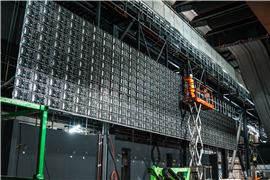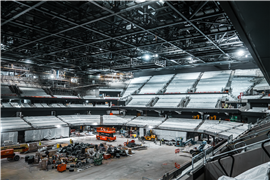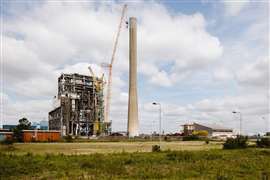Read this article in 中文 Français Deutsch Italiano Português Español
The challenges in building UK’s ‘most sustainable’ entertainment venue
23 April 2024
When the likes of Olivia Rodrigo, Nicki Minaj and the Eagles appear at the newly constructed, £365 million Co-Op Live arena in Manchester later this year, they’ll be performing in what is claimed to be the UK’s ‘most sustainable’ entertainment venue.
 Bianca Binder, principal at Populous and project delivery lead at Co-op Live (Photo: Populous)
Bianca Binder, principal at Populous and project delivery lead at Co-op Live (Photo: Populous)
The opening of the venue is running behind schedule - originally slated for April this year, it has now been pushed back to May because it is still testing procedures for handling largescale audiences.
Designed by sports venue architecture specialist Populous and built by BAM Construction for venue developer Oak View Group (OVG), Co-Op Live sits in the shadow of Manchester City’s Etihad stadium.
And in spite of its size - it’s also billed as being the largest indoor entertainment venue in the UK - the target is for the building to be net carbon neutral by 2038.
That’s thanks in part to the almost 9,000 sq m of photovoltaic solar panels on the venue’s 10,500 sq m roof. The building, heated with air source heat pumps, is fully electric, with the solar panels topped up by renewably sourced electricity. To minimise thermal losses, it has been built with high-spec insulation and a perforated facade designed to provide internal shading.
It’s also festooned with technology including an extensive smart metering system and smart building controls to regulate heating, cooling and ventilation in occupied areas.
Meanwhile, the toilets in the venue are flushed using water from a rainwater harvesting system and the building promises zero waste direct to landfill in operation.
For Bianca Binder, a principal at Populous and project delivery lead for Co-op Live, the launch of the venue will mark the end of a complex but satisfying construction project that started in the teeth of the Covid-19 pandemic.
“It’s incredibly rewarding to see everything coming together ahead of the launch, knowing the challenges we faced throughout the process,” Binder tells Construction Briefing.
Sustainability has been key to both the design and construction from the outset and to maintain a low carbon footprint, much of the materials and orders were sourced locally, she says.
“Overall, 80% of construction orders were placed with local businesses in the North-West of England, over half of which are in the Greater Manchester area,” she says. “This means that £200 million of the arena funding has been spent within the local economy and that the distances travelled by the lorries delivering the construction materials were minimised.”
 The construction process at Co-op Live on 13th February 2024 (Photo: Co-op Live)
The construction process at Co-op Live on 13th February 2024 (Photo: Co-op Live)
Challenges to overcome
Those who spearheaded the project had to explore innovative construction techniques and materials due to their strong focus on sustainability, but this did not come without challenges.
For Binder, the central location of the site meant that they had to think creatively to overcome some of the logistical challenges of construction. Binder says, “On a basic level, there wasn’t enough room for the tower cranes to be installed on the boundary of the site as they normally would be.
“This meant the roof trusses had to be assembled on the arena floor and then lifted into place with crawler cranes placed within the footprint of the building, which is quite unusual for a project of this scale. The process had to be carefully planned and coordinated with the digital construction model to ensure the job was carried out safely and successfully.”
 The construction process at Co-op Live on 13th February 2024 (Photo: Co-op Live)
The construction process at Co-op Live on 13th February 2024 (Photo: Co-op Live)
In addition to this, Binder adds that the building’s seven cores were cast off-site using a twin-wall construction method, which reduced the number of concrete deliveries to the site and, in turn, the carbon footprint of the project. Like the crane movements, this was said to be all carefully planned and coordinated using the digital construction model.
Building the project has not come without challenges highlights Binder. Ground was broken just after the first wave of the pandemic at a time when travel was extremely limited and a lot of coordination work was moved online.
Binder says, “There was also major disruption to some of the supply chains, as well as challenges related to the site being a former coal mining area, with shafts requiring remediation before starting piling and a primary sewer cutting through the site that had to be rerouted. Ultimately, we were able to overcome these challenges by having an incredibly knowledgeable and experienced team and by switching to a ‘just-in-time delivery’ approach, where materials and the different components of the building were delivered to the site only as they were needed in the build.
Looking ahead, Construction Briefing asks Binder what her expectations were for the impact of the Co-op Live project on the future construction of large-scale venues and whether they would move towards more sustainable solutions.
Binder says, “The digital tools to aid design, planning and delivery in construction have come on leaps and bounds in the last decade and will continue to evolve. These programmes mean that the construction process can be made as efficient as possible, reducing material wastage and site deliveries. These factors contribute significantly to the carbon footprint of a project.”
|
STAY CONNECTED


Receive the information you need when you need it through our world-leading magazines, newsletters and daily briefings.
CONNECT WITH THE TEAM











